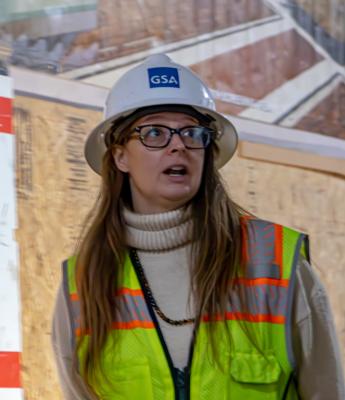Erin Holcombe is challenging the stereotype

Erin Holcombe
Project Manager
Design and Construction
Three years working at GSA
The Frank E. Moss U.S. Courthouse in Salt Lake City is a $161 million project for GSA and the largest currently in the Rocky Mountain Region. Leading this major effort is not who you would expect.
Erin Holcombe, currently a project manager based in Salt Lake City, is also a licensed architect. She is a rarity in her field where women make up roughly 26%, according to the American Institute of Architects.
Originally, Holcombe set her sights on becoming a surgeon but just before finishing her bachelor’s degree she realized she had more of a creative side and changed majors. She chose architecture as her field though not really knowing much about it initially.
“Architecture and building really sparked a passion in me that fired both sides of my brain,” said Holcombe. “Architecture is art that you can walk through, that you can touch and interface with, it is an experience that everyone has access to.”
She has been with GSA for only a couple of years but is already heading up a major project, which signifies the trust regional leadership has in her abilities.
The road she took to get to this point was long with twists and turns along the way. Holcombe got her bachelor’s degree from the University of Utah and then went on to complete her masters program at North Carolina State University in 2008. She stated, you don’t just get your degree and automatically start being an architect. The process includes two and half years of continuous internship in addition to seven exams.

For young aspiring architects who are in their mid- to late-20s, who are looking to settle down to have a family, working 50-60 hours a week and studying on top of that for the exams can be very daunting.
“We used to joke that we (architects) have more school than lawyers and get paid about 10% of what they make,” mused Holcombe.
Coming out of college, the housing bubble hit most of the East Coast right about then so she came back to Utah pursuing a job. She was hired by a private firm and worked there for 12 years designing and managing building projects for clients ranging from municipalities, police stations, fire stations and even courts. That is how she started working with GSA. She had been a contractor working with GSA on a number of projects.
“It is funny because one of the projects I helped design and was about to guide into construction was the Moss Courthouse,” said Holcombe. “So I got to come full circle when I came to GSA full time.”
The architecture sector is known for being male dominated. She noted some of the struggles female architects have for advancement or pay increases goes back to the perception. Most women work normal hours in the office, return home to care for their family, and then resume work remotely after hours, while men typically have the opportunity to work all hours in the office.
This gives the perception that men are going above and beyond, while women are doing just enough because the physical presence in the office is different. It is important to emphasize that men and women usually have the same workload, they just perform their work differently. The difference in time spent at the office is because women with children have a more prominent role in taking care of the family than men do.
Holcombe acknowledges in her case, performance was never taken into consideration. While she may have managed her time more effectively or got as much done as the other person, she may not be putting in long hours at the office due to family responsibilities. She offers that she has had to make concessions as a single mother.
“I remember when I had my second child and telework was just starting to be a thing, I struggled to work while I was on maternity leave,” said Holcombe. “I took three days off from work and then started working from home with a tiny baby and a 2-year-old to care for.”
Holcombe persevered and credits a mentor with helping her prepare for working with male clients on a job site. This mentor taught her how to be more observant at the job site and urged her to engage with the contractors to build trust with them to show that she knew her craft.
“Once they understood that I did know what I was talking about, it got better,” said Holcombe. “But at each project I would have to start all over again.”
Her advice to others who are faced with similar challenges is to always go into a meeting prepared and always walk the jobsite with intention and confidence.

 U.S. General Services Administration
U.S. General Services Administration